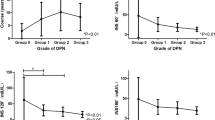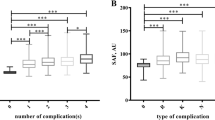Abstract
Background: The accumulation of advanced glycation end products (AGEs) has a key role in the pathophysiology of diabetes complications. Comparison of AGEs measurement in serum, skin, saliva and urine has not been reported. Aims: To compare AGEs in serum, skin, saliva and urine in patients with Type 2 diabetes mellitus, with complications at different stages. Materials and Methods: We examined 50 patients with Type 2 diabetes mellitus (40 women and 10 men) grouped according to the progression of neuropathy, nephropathy and retinopathy. The AGEs content in serum, skin, saliva and urine was measured by spectrofluorometry HPLC. Results: The patients had a mean age of 56.5±7.7 yr and 12.8±6.7 yr since diagnosis. AGEs in skin correlated with years since diagnosis (p=0.0005). AGEs in serum, skin and saliva increased with the progression of complications, nevertheless, in urine a trend to diminution was found. In the group with end-stage renal disease (ESRD), AGEs in serum increased in greater proportion. In order to account for the decreased AGEs clearance, we corrected the values for creatinine levels, and AGEs in skin gave a better association with complications. Conclusions: The AGEs measurement in skin, serum and saliva are useful to evaluate diabetes complications. AGEs in skin are associated with years since diagnosis of diabetes. Correction for renal function might discriminate AGEs in situ formation from accumulation.
Similar content being viewed by others
References
DCCT Research Group. The effect of intensive treatment of diabetes on the development and progression of long term complications in insulin-dependent diabetes mellitus. N Engl J Med 1993, 14: 977–86.
Bucala R, Cerami A, and Vlassara H. Advanced glycosylation end products in diabetic complications. Diabetes Rev 1995, 3: 258–68.
Friedman EA. Advanced glycosylation end products and hyperglycemia in the pathogenesis of diabetic complications. Diabetes Care 1999, 22 (Suppl 2): B65–71.
Rudeman N, Williamson J, Brownlee M. Glucose and diabetes vascular disease. FASEB J 1992, 6: 2905–14.
Mendez JD. Advanced glycosylation end products and chronic complications of diabetes mellitus. Gac Med Mex 2003, 139: 49–55.
Ikeda K, Higashi T, Hiroyuki S, et al. Nε(Carboxymethyl)lysine Protein Adduct Is a Major Inmmunological Epitope in Proteins Modified with Advanced Glycation End Products of the Maillard Reaction. Biochemistry 1996, 35: 8075–83.
Shinohara M, Thornalley PJ, Giardino I, et al. Overexpression of glyoxalase-I in bovine endothelial cells inhibits intracellular advanced glycation endproduct formation and prevents hyperglycemia-induced increases in macromolecular endocytosis. J Clin Invest 1998, 101: 1142–7.
Vander Jagt DL, Robinson B, Taylor KT and Hunsaker LA. Reduction of trioses by NADPH-dependent aldo-keto reductases. Aldose reductase, methylglyoxal, and diabetic complications. J Biol Chem 1992, 267: 4364–9.
Goldberg T, Weiining C, Melpomeni P, Vlassara H. Evaluation of daily consumption of advanced glycoxidation end-products in healthy and diabetic type 2 subject. Diabetes Abstract book 63rd scientific sessions 2003, A554.
Brownlee M, Cerami A, Vlassara H. Nonenzymatic glycosylation and the pathogenesis of diabetic complications. Ann Intern Med 1984, 101: 527–37.
Belmin J, Valensi P. Diabetic neuropathy in elderly patients. what can be done? Drugs Aging 1996, 8: 416–29.
He C, Sabol J, Mitsuhashi T Vlassara H: Dietary glycotoxins: inhibition of reactive products by aminoguanidine facilitates renal clearance and reduces tissues sequestration. Diabetes 1999, 48: 1308–15.
Hofmann SM, Dong HJ, Li Z, et al. Improved insulin sensitivity is associated with restricted intake of dietary glycoxidation products in the db/db mouse. Diabetes 2002, 51: 2082–9.
Vlassara H, Palace MR. Diabetes and advanced glycation endproducts. J Intern Med 2002, 251: 87–101.
Makita Z, Radoff S, Rayfield EJ, et al. Advanced glycosylation end products in patients with diabetic nephropathy. N Engl J Med 1991, 325: 836–42.
Garay-Sevilla ME, Nava L, Malacara JM, Wrobel K, Wrobel K, Pérez U. Advanced glycosylation end products (AGEs), insulin-like growth factor-1 (IGF-1) and IGF-binding protein-3 (IGFBP-3) in patients with type 2 diabetes mellitus (DM). Diabetes Metab Res Rev 2000, 16: 106–113.
Makita Z, Vlassara H, Cerami A and Bucala R. Inmunochemical detection of advanced glycosylation end products in vivo. J Biol Chem 1992, 267: 5133–8.
Dolhofer-Bliesener R, Lechner B, Gerbitz KD. Possible significance of advanced glycation end products in serum in end-stage renal disease and in late complications of diabetes. Eur J Clin Chem Clin Biochem 1996, 34: 355–61.
Yanagisawa K, Makita Z, Shiroshita K et al. Specific fluorescence assay for advanced glycation end products in blood and urine of diabetic patients. Metabolism 1998, 47: 1348–53.
Singh R, Barden A, Mori T, Beilin M. Advanced glycation end-products: a review Diabetología 2001, 44: 129–46.
Brownlee M, Cerami A, Vlassara H. Advanced glycosylation end products in tissue and the biochemical basis of diabetic complications. N Engl J Med 1988, 318: 1315–21.
Beisswenger PJ, Makita Z, Curohey TJ, et al. Formation of inmunochemical advanced glycosylation end products procedures and correlates with early manifestations of renal and retinal disease in diabetes. Diabetes 1995, 44: 824–9.
Wróbel K, Garay-Sevilla ME, Nava LE, Malacara JM. Novel analytical approach to monitoring advanced glycosylation end products in human serum with on-line spectrophotometric and spectrofluorometric detection in flow system. Clin Chem 1997, 43: 1563–9.
Beisswenger PJ, Moore LL, Curphey TJ, et al. Relationship between glycemic control and collagen-linked advanced glycosylation end products in type 1 diabetes. Diabetes Care 1993, 16: 689–94.
Viberti G. Recent advances in understanding mechanisms and natural history of diabetic renal disease. Diabetes Care 1988, 11: 3–9.
ETDRS Coordinating Center: Manual of Operations. Baltimore, MD, Diabetes Retinopathy Coordinating Center 1980, chapt 2.
Feldman EL, Stevens MJ, Thimas PK, Brown MB, Canal N, Greene DA. A practical two-step Quantitative Clinical and Electrophysiological Assessment for The Diagnosis and Staging of Diabetic Neuropathy. Diabetes Care 1994, 17: 1281–9.
Carrington AL, Litchfield JE. The aldose reductase pathway and nonenzymatic glycation in pathogenesis of diabetic neuropathy: a critical review to the end of the 20th century. Diabetes Rev 1999, 7: 276–99.
Vlassara H, W Cai, Crandall J, et al. Inflamatory mediators are induced by dietary glycotoxins, a major risk factor for diabetic angiopathy. Proc Natl Acad Sci U S A 2002, 99: 15596–601.
Reeves BW, Andreoli TE. Transforming Growth factor-β contributes to progressive diabetic nephropathy. Proc Natl Acad Sci U S A 2000, 97: 7667–69.
Monnier VM, Bautista O, Kenny D, et al. Skin collagen glycation, glycoxidation, and crosslinking are lower in subjects with long-term intensive versus conventional therapy of type 1 diabetes: relevance of glycated collagen products versus HbA1c as markers of diabetic complications. DCCT skin collagen ancillary study groups. Diabetes Control and Complication Trial. Diabetes 1999, 48: 870–80.
McCance DR, Dyer DG, Dunn JA, et al. Maillardreaction products and their relation to complications in insulin-dependent diabetes mellitus. J Clin Invest 1993, 91: 2470–8.
Lyons TJ, Bailie KE, Dyer DG, Dunn JA, Baynes JW. Decrease in skin collagen glycation with improved glycemic control in patients with non-insulin-dependent diabetes mellitus. J Clin Invest 1991, 87: 1910–5.
Miyata T, Ueda Y, Horie K, et al. Renal catabolism of advanced glycosylation end products: The fate of pentosidine. Kidney Int 1998, 53: 416–22.
Shimoike T, Inoguchi T, Umeda F, Nawata H, Kawan K, Ochi H. The meaning of serum level of advanced glycosylationend products in diabetic nefropathy. Metabolism 2000, 49: 1030–5.
Sell DR, Monnier VM. End-Stage Renal Disease and diabetes catalyzed deformation of a pentose-derived cross link from ageing human collagen. J Clin Invest 1990, 85: 380–4.
Odetti P, Fogarty J, Sell DR, Monnier VM. Chromatographic quantitation of plasma and erythrocyte pentosidine in diabetic and uremic subjects. Diabetes 1992, 41: 153–9.
Takahahi M, Kushida K, Kawana K, et al. Quantification of the cross-link pentosidine in serum from normal and uremic subjects. Clin Chem 1993, 39: 2162–5.
Meng J, Sakata N, Imanaga Y, Takebayasgi S, Nagai R, Horiuchi S. Carboxymehyllisine in dermal tissues of diabetic and nondiabetic patients with chronic renal failure: relevance to glycoxidation damage. Nephron 2001, 88: 30–35.
Author information
Authors and Affiliations
Corresponding author
Rights and permissions
About this article
Cite this article
Garay-Sevilla, M.E., Regalado, J.C., Malacara, J.M. et al. Advanced glycosylation end products in skin, serum, saliva and urine and its association with complications of patients with Type 2 diabetes mellitus. J Endocrinol Invest 28, 223–230 (2005). https://doi.org/10.1007/BF03345377
Accepted:
Published:
Issue Date:
DOI: https://doi.org/10.1007/BF03345377




